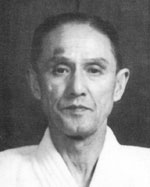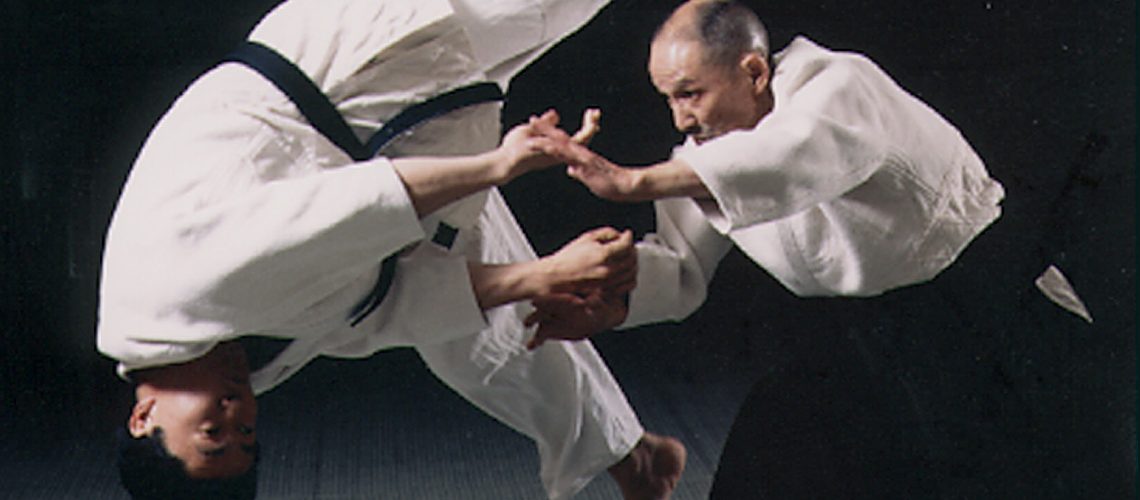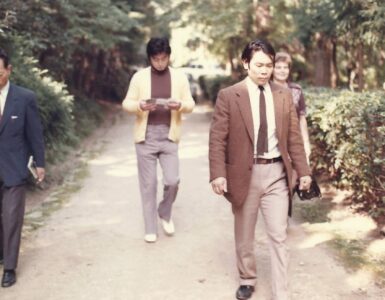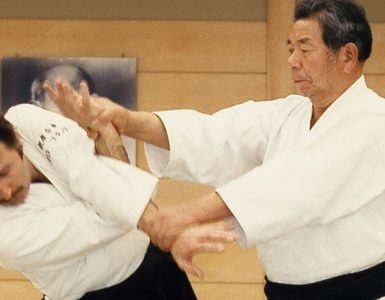
The following translation from the Japanese-language autobiography entitled Aikido Jinsei (An Aikido Life) by Gozo Shioda Sensei of Yoshinkan Aikido is published with the kind permission of the author and the publisher, Takeuchi Shoten Shinsha. The series began with AIKI NEWS No. 72, this being the eighth installment. Read the seventh installment here.
Chapter Two: Training At The Ueshiba Dojo

Sensei always used to say, “Be honest,” and “Trust your teacher.” For example, out of respect towards his teacher, a student should be willing to eat excrement without any hesitation if he is told to do so by his teacher. According to Sensei, that sort of experience would prove beneficial to a student in the long run. This, of course, is an extremely strong example, but it shows the degree of trust one should have towards one’s teacher. I trained hard every day repeating the same routine.
Ueshiba Sensei was very religiously oriented. He regarded Mr. Onisaburo Deguchi of the Omoto religion as his master. He firmly believed that having Mr. Deguchi as his teacher would make it possible to attain eternal power. Therefore, his religious services in the morning and evening used to be a major event each day. Sensei recited Shinto prayers and then offered thanks to the kami or deities (starting with the Sun Goddess to the kami of water and grass). The whole ritual took approximately one and a half hours every day. Sensei was especially severe with respect to the kami and even the slightest mistake by his students during the daily ritual would raise his ire. That was one aspect of the most difficult training we experienced. I personally could not commit myself to believing in the kami and I only followed my teacher.
Sensei said in one of his lectures, “Man himself is a palace of flesh wherein the kami reside. Therefore, we should keep our bodies clean so as to seek divine instruction.” I believed that was true. I also did research into Kamiikido myself. I used to put a goldfish in a bowl and tap on the outside to observe the movements of the goldfish. Another thing I tried was hanging a stick in a high place in the house under which I frequently walked. It was set in such a way that it would hit me if I passed under it without paying attention. In that way I always would think about body positioning, eliminate any openings, train my body movements and sharpen my intuition.
Severe Training
Ueshiba Sensei used to hold outdoor training sessions once a year. This was usually in a town called Takeda located near Himeji City in Hyogo Prefecture. Approximately 40 live-in students gathered together there for a 20-day summer training session.
It started with prayer exercises for about one and a half hours starting at five in the morning. Then we performed purification rituals for another hour. After breakfast, the period of training started at around ten and lasted until lunch time. We rested for about two hours after lunch. Then training resumed at four in the evening and lasted until six. During this special seminar we practiced outdoors every other day. This was especially hard.
Mr. Tsutomu Yukawa, one of the live-in students at that time was a man of great strength. His physical power was such that he could easily lift a Japanese stone mill with one hand while lying on his back. One day, Yukawa decided he was going to attempt to uproot a tree of about four inches in diameter which was growing in the garden of the boarding house. His face became completely red as he attempted to pull out the tree. However, the tree was apparently rooted very deep and withstood his effort. Upon seeing his student’s unsuccessful attempt, Ueshiba said, “Hey, Yukawa. What are you doing? Let me have a try.” Sensei walked up to the tree and held it firmly in his arms. The next instant, the tree was out of the ground. At this sight, even the powerful Yukawa had to admit his defeat. Since Sensei pulled the tree up so lightly, I tried the same thing too with a similar-sized tree, but could not even budge it an inch. Just as the expression goes, it was “firmly rooted in the ground.” That was only one example which showed how extraordinary Sensei was. He was called a guardian kami and used to do things beyond the reach of human power.
Attack With A Real Spear
One day, a public prosecutor visited Ueshiba Sensei in Takeda. While they were having a pleasant chat in a four and a half mat room, Sensei had one of his students attack him with a spear with all his might. He was wearing a crested ceremonial garment of silk. It was a small room and the attack distance was extremely short. Also, the student had been told to attack vigorously, so Sensei had to evade instantly.
Sensei said in one of his lectures, “Man himself is a palace of flesh wherein the kami reside. Therefore, we should keep our bodies clean so as to seek divine instruction.” I believed that was true. I also did research into Kamiikido myself. I used to put a goldfish in a bowl and tap on the outside to observe the movements of the goldfish. Another thing I tried was hanging a stick in a high place in the house under which I frequently walked. It was set in such a way that it would hit me if I passed under it without paying attention. In that way I always would think about body positioning, eliminate any openings, train my body movements and sharpen my intuition.
At the moment of attack, Sensei opened his body to the side. However, the tip of the spear caught a section of his kimono sleeves and it fluttered down to the floor. Sensei’s wife saw what happened and asked him to stop. This ended that particular training episode. Sensei’s facial expression did not change even slightly from his usual gentle appearance. He said, “No matter how swift the attack, it cannot touch my body. The spear took the trouble to miss me.” These words were true only because Sensei was no common man. If he had been an ordinary person like us, he would have been skewered! I have a virtually inexhaustible supply of stories about Sensei such as this.
Around that time Ueshiba Sensei was instructing for half of the month in Osaka and the other half in Tokyo. The first training in Osaka dates back to the Sumitomo Club. Since Marquis Toshitame Maeda in Osaka (a lieutenant-general who trained at the Ueshiba Dojo who died in Borneo) was related by marriage to the Sumitomo family, he told Mr. Masatsune Ogura, an influential figure in the Sumitomo organization, about Ueshiba Sensei. A large number of Sumitomo employees gathered at the Sumitomo Club in Horifune-cho to practice under Ueshiba Sensei.
Ueshiba Sensei also gave instruction to employees of the Osaka Blue Bus, to an association of reservists, and several teachers of martial arts including a certain Koga Sensei who was a high-ranking Kendo instructor at the Osaka Shimanouchi Police Department. Ueshiba Sensei’s Osaka Dojo used to be located in Suita and is still in existence. When Sensei was not in Osaka, Rinjiro Shirata was in charge and taught at the Osaka Dojo. Tsutomu Yukawa (now deceased) also taught in several locations in Osaka including a special police force dojo.
Ueshiba Sensei’s “Electric Sense”
I used to accompany Ueshiba Sensei everywhere. One of the many ways in which he was different from ordinary people was in his unusually sharp senses, especially with regard to electricity. He used to dislike electricity because it had a negative effect on him. In those days, the National Railways’ electric train in Tokyo used to be called the shosen. In order to go to Okawa Sensei’s dojo in Meguro, Sensei never rode the shosen. Instead, he took the shiden, which later became the toden, a street railway, because it used less electricity than the former and consequently, had a lesser negative effect on him. He boarded the streetcar at Nuke-Benten which went to Tsunohazu where he changed trains to reach Yotsuya Shio-machi. (At that time one ticket would take you anywhere and you could even make a transfer. The ticket cost seven sen.) At Yotsuya Shiomachi he took another streetcar to Gyoranzaka where he then changed trains to proceed to Meguro. Whichever student accompanied Ueshiba Sensei on that trip had a difficult time of it having to carry his training garb, wooden sword, knife, and so on. The whole trip took more than one and a half hours. If he had chosen the shosen it would have taken less than half the time. Although the student who went with Sensei had a hard time following him to the dojo in Meguro, they saved money because it only cost 14 sen per head both ways.
Mr. Tsutomu Yukawa, one of the live-in students at that time was a man of great strength. His physical power was such that he could easily lift a Japanese stone mill with one hand while lying on his back. One day, Yukawa decided he was going to attempt to uproot a tree of about four inches in diameter which was growing in the garden of the boarding house. His face became completely red as he attempted to pull out the tree. However, the tree was apparently rooted very deep and withstood his effort. Upon seeing his student’s unsuccessful attempt, Ueshiba said, “Hey, Yukawa. What are you doing? Let me have a try.” Sensei walked up to the tree and held it firmly in his arms. The next instant, the tree was out of the ground. At this sight, even the powerful Yukawa had to admit his defeat.
One day when I accompanied Ueshiba Sensei on a streetcar, a pickpocket was apparently trying to steal his wallet which he kept in his kimono. Even though I did not notice the pickpocket, I did see Sensei fold his arms across his chest. He used to always wear a Japanese kimono and rarely wore western clothes. When the streetcar arrived at Tsunohazu, Sensei said to the man, “You dropped ten sen.” That 10 sen was Sensei’s and I did not understand why he was giving money to a total stranger. When I asked him the reason, he said, “That man took the trouble to try to get my wallet and failed. That’s why I gave it to him.” I had not even noticed that the man was a pickpocket until he told me. Still, I felt sorry for the man for his miserable attempt.
Training At The Naval Staff College
When Ueshiba Sensei taught at the Naval Staff College, Admiral Sankichi Takahashi was its president. I accompanied Sensei to the college once. His Imperial Highness Prince Takamatsu was a student at the college and so there existed a tense atmosphere inside the school. Since Ueshiba Sensei was a firm believer in the “Emperor First” principle, he exerted himself to the utmost not to be impolite to a member of the Imperial Family. When we took falls for Sensei, we were not allowed to raise my legs. We had to take falls flat like a dried fish! Sensei was afraid we might hit a member of the Imperial Family in the face with our feet.
As a result of that careful demonstration, six princes started to train. They were Their Imperial Highnesses Prince Takamatsu, Prince Higashikuni, Prince Takeda, Prince Chichibu, Prince Rio and Prince Kitashirakawa. Their Imperial Highnesses Prince Higashikuni and Prince Rio came to the Ueshiba Dojo to train.
Sensei went to the Imperial Palace to give instruction to Their Imperial Highnesses Prince and Princess Takeda. Ueshiba Sensei often took me there because he did not wish to be impolite to the Imperial Family. Her Imperial Highness was a daughter of Count Sano and extremely beautiful. I trained with her treating her like a fragile article. When she touched me even very lightly, I tried to leap and take a fall as far as possible. I think this experience was very useful as far as my own training in taking breakfalls was concerned. Among the six princes, Their Imperial Highnesses Prince Higashikuni, Prince Rio and Prince Takeda trained the longest, for about three years.
Special Training In Kyoto
In the compound of the Kyoto Botanical Garden, there is a place halfway up the hill where it is said that the famous Ushiwakamaru (childhood name of Yoshitsume Minamoto) trained. It forms a basin and was a perfect spot for outdoor aikido training. About 50 yards away, there was a small house with about three rooms which was purported to be the house where the famous Confucian scholar Razan Hayashi Sensei was born in the Edo Period. Ueshiba Sensei rented that house and lived and trained there for 20 days with a few of his top students. There were Rinjiro Shirata, who was in charge of the dojo in Osaka, Saburo Wakuta (Tenryu, a former Sumo wrestler) and myself.
At the moment of attack, Sensei opened his body to the side. However, the tip of the spear caught a section of his kimono sleeves and it fluttered down to the floor. Sensei’s wife saw what happened and asked him to stop. This ended that particular training episode. Sensei’s facial expression did not change even slightly from his usual gentle appearance. He said, “No matter how swift the attack, it cannot touch my body. The spear took the trouble to miss me.” These words were true only because Sensei was no common man. If he had been an ordinary person like us, he would have been skewered! I have a virtually inexhaustible supply of stories about Sensei such as this.
When Sensei walked up a hill he used to always have a student push him from the back. The three of us took turns. While being pushed, he was leaning almost completely backward and walked in a swaggering manner. Since I was very mischievous, I thought I would try to take my hands off Sensei’s back to see if he would fall backwards when it was my turn. When I felt the weight of Sensei’s body, I decided to let my hands go. The next instant Sensei was standing firmly on his feet showing no change. Sensei said, “What are you doing, Shioda. The kami are guarding me and tell me you are into some mischief. They said, ‘He is going to do it, he is going to do it!’” I was astonished and felt all the more keenly that Sensei was an embodiment of the martial spirit. I was impressed even more than before that Ueshiba Sensei was a perfect martial kami who was always alert and never had any openings. Again, this is only one of numerous stories about Ueshiba Sensei.
Professor Kenzo Futaki, who was an honorary professor of the Tokyo Imperial University and awarded the Order of Cultural Merit, was famous for his brown rice diet. He lived to be 96 years old and used to train at the dojo. Professor Futaki came to train every morning from his house near the dojo. He used to come to the dojo already wearing his training outfit, although in winter he wore a cape on top. Ueshiba Sensei respected Professor Futaki and said to him, “Please try any technique you like.” Then the professor would train freely with four or five young fellows in the dojo. When he got tired, he said, “Okay, enough for today.” He clapped his hands and returned home.
One day Professor Futaki said to Ueshiba Sensei, “Sensei, I am going to attack you with a bokken. Can you escape from my attack?” Sensei answered smilingly, “Anytime.” When the professor used to attack Sensei from the front during demonstrations, Sensei always evaded to the left. So this time, he anticipated and decided to make an attack to the direction in which Sensei always evaded. As a result, Professor Futaki’s attack missed Sensei again, because Sensei did not move. The professor of course admitted his defeat.
When Professor Futaki asked Sensei how he could tell the direction of his attack, he responded, “Your mind had already flown to the right. Your empty-spirited body made that attack ever so slowly!” Hearing this, Professor Futaki looked puzzled. We also felt the same way as the Professor and were unable to understand.













Add comment